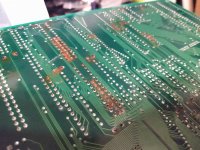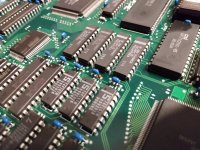So I recently picked up a Kaneko Blazeon, the board works fine but bizarrely has rust on a number of pins. This board doesn't have a battery nor is this related at all to leaking caps. it looks like legit iron rust.


some additional photos: https://photos.app.goo.gl/uhNsT5FpcDgtjxVh9
if it looks wet that's because I've gone over it with some DeOxit.. which seems to have done nothing at all to help.
A handful of pins seem to have rusted through to the top side. too.
I'm a bit at a loss for what to do about it. out of the hundreds of boards I've bought over the years I've never seen a board rust like this I've seen suggestions online for using baking soda or vinegar. but I'm hesitant to just start mixing chemicals on this thing.
the PCB is pretty mint otherwise and like I said it currently works fine, but I'd like to make sure it stays working for the foreseeable future.
anyone dealt with this successfully before? how did you do it?


some additional photos: https://photos.app.goo.gl/uhNsT5FpcDgtjxVh9
if it looks wet that's because I've gone over it with some DeOxit.. which seems to have done nothing at all to help.
A handful of pins seem to have rusted through to the top side. too.
I'm a bit at a loss for what to do about it. out of the hundreds of boards I've bought over the years I've never seen a board rust like this I've seen suggestions online for using baking soda or vinegar. but I'm hesitant to just start mixing chemicals on this thing.
the PCB is pretty mint otherwise and like I said it currently works fine, but I'd like to make sure it stays working for the foreseeable future.
anyone dealt with this successfully before? how did you do it?
Last edited:

